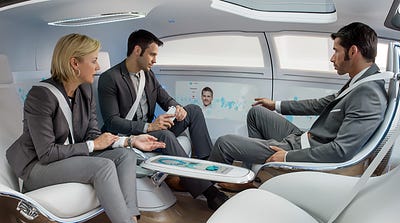Self-driving cars will kill the urban renaissance, and we’ll be happy about it

Autonomous cars will reverse the trend of young professionals and Baby Boomers moving from the suburbs to cities, and will kill the recently emerging metropolitan renaissance. This will make us a much happier society.
For decades Boomers and Yuppies fled cities for the suburbs, especially when they decided to breed. The burbs were safer, cleaner, had better infrastructure and amenities, and more room for the rugrats to play. However, following the 2008 financial crisis, this trend started to reverse. Migration into the city core from the suburbs started to accelerate as cities invested in their core infrastructure and increasing affluent populations created a virtuous cycle. More and more amenities catered to those affluent populations, which in turn drew more of the population seeking those amenities.
Extreme commute times also drove people from the suburbs to the cities. The numbers are appalling. Average commuting delays due to traffic doubled from 1985 to 2015. The mean commute time for suburban residents working in Washington DC is over 40 minutes. In New York city the average commute is 41 minutes and 25% of commuters spend more than an hour commuting. Commuters in DC could expect to spend an average of 82 extra hours on the road due to traffic. In LA. the annual wasted in traffic is 80 hours and in San Francisco it’s 78 hours. That’s nearly two, full extra work-weeks spent sitting in traffic.
Let me say that again — if you commute from the suburbs in DC, LA or SF, you will spend a full two work-weeks in traffic. That’s a waste of your life and your time. Is it any wonder people want to live in the city where their commute time is shorter?
All of that is going to change when your car can drive itself to work. Autonomous vehicles will drastically reduce traffic and commute times from the suburbs, reversing the migration to city cores and effectively ending the urban renaissance.
How and why?
When cars don’t need drivers, cars will transform into small mobile living rooms where commuters can work, read, sleep, watch TV- basically anything they prefer other than driving the car. Immediately, there are two work-weeks of productivity you can have back.
Eventually, states or the Federal Government will mandate that all cars on the freeway must be autonomous. When this happens, they will use mesh-networks to coordinate their actions and avoid collisions. This will allow cars to 1) follow each other very closely, accelerate and brake simultaneously; and 2) travel at speeds which would be unsafe for human drivers.
Highways can handle many more autonomous cars because they can travel nearly bumper to bumper. The extra space humans require as a following distance to avoid accidents is unnecessary and can be filled with more autonomous cars. Traffic jams will be a relic of the past. Accidents on the freeway will drop to nearly zero.
Once the government requires all cars to be autonomous, even on surface streets, there are additional advantages. First, accidents everywhere would drop to nearly zero as you remove the fallible human element. Computers don’t get drunk (they do crash, which is why every vehicle will have a failsafe so a CPU crash doesn’t crash you). Second, commute times in city traffic will dramatically decrease. Autonomous cars don’t need to stop at intersections. They can just time their path so they barely miss intersecting traffic.
This continual process of near-misses will be terrifying, so most will choose to travel with their windows opaque, perhaps with their favorite show or some soothing virtual environment displayed on a screen instead of near-collisions.
These will be massive time savers. Commutes which took an hour in inescapable traffic or thirty minutes in no traffic at 5am will take twenty minutes in an autonomous car at any time of day. And since you aren’t busy driving, you can use that time productively on anything you want.
So why live in the city, where your bus or walk to work might be 15 minutes, when you can live in a bigger space in the suburbs, have a 20 minute commute, and keep that time available to do whatever you want?
Autonomous cars will also facilitate living extremely far from urban cores. Many will choose to live 100 miles from a major city, on a farm or in the woods, if their commute is only an hour and they could use that time conducting work or. hobbies. Temporal liberation facilitates geographic freedom.
This will reverse many of the demographic incentives currently driving people to migrate back to city cores. Instead of paying exorbitant rents for small, urban apartments with no outdoor space, professionals will move back to the suburbs, choosing to live in large houses with yards, away from the noise and pollution of the city. No longer facing the waste of their most precious asset — their time — the affluent will choose to live outside urban areas where they have access to nature and space.
The amenities now in the city will follow them. What will happen to the cities? Who knows. Perhaps they will resume their cycle of decay, or perhaps less wealthy, entry-level professionals and blue collar workers will move into the cramped spaces evacuated by their more affluent neighbors. The fate of the urban core is a wildcard, but it’s almost certain that autonomous cars will end the urban renaissance and resume professional flight to the suburbs, all while shortening commute times, with less traffic than ever.
This will make us happier. Studies consistently show that people are most unhappy when they are commuting. This is because they feel out of control — at the mercy of traffic or a public transit driver — and it’s essentially seen as wasted time, especially for drivers. When commuters take back control of their time and their lives, commute times might actually increase along with happiness, because commuters will be spending the time as they wish, not navigating a metal box through a congested deathtrap of concrete, asphalt and steel and living as far from the city as they wish, in suburban paradise.
Coming soon to a future near you.
Next up: some of the interesting things you’ll be able to do in your self-driving car. Read Bring on the Spin Bus! Thanks for reading!
{title image courtesy of Mercedes-Benz}

